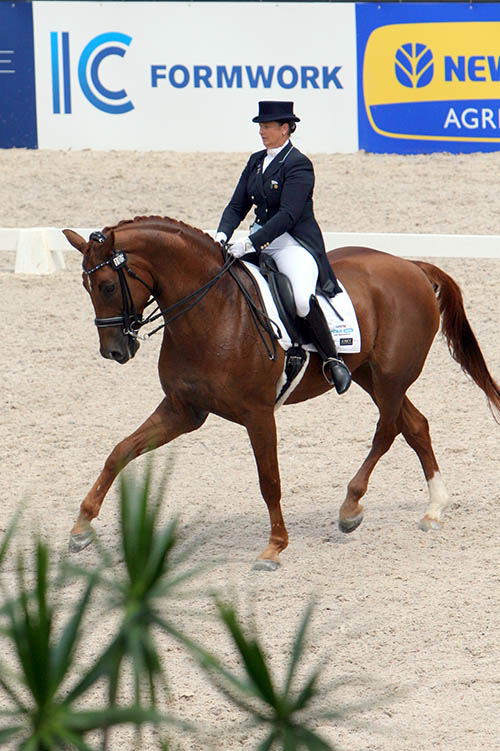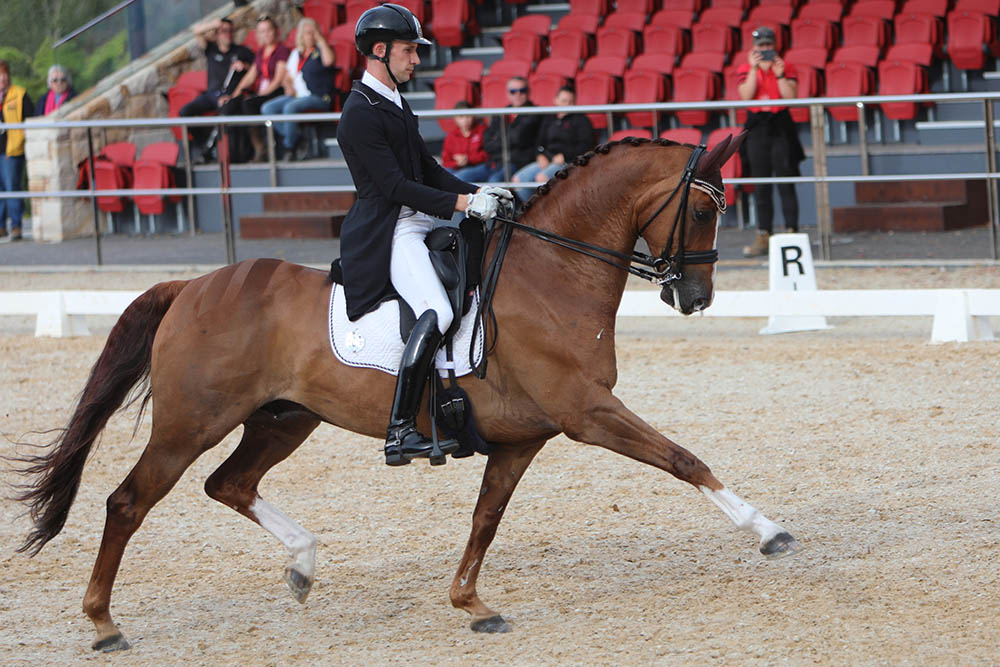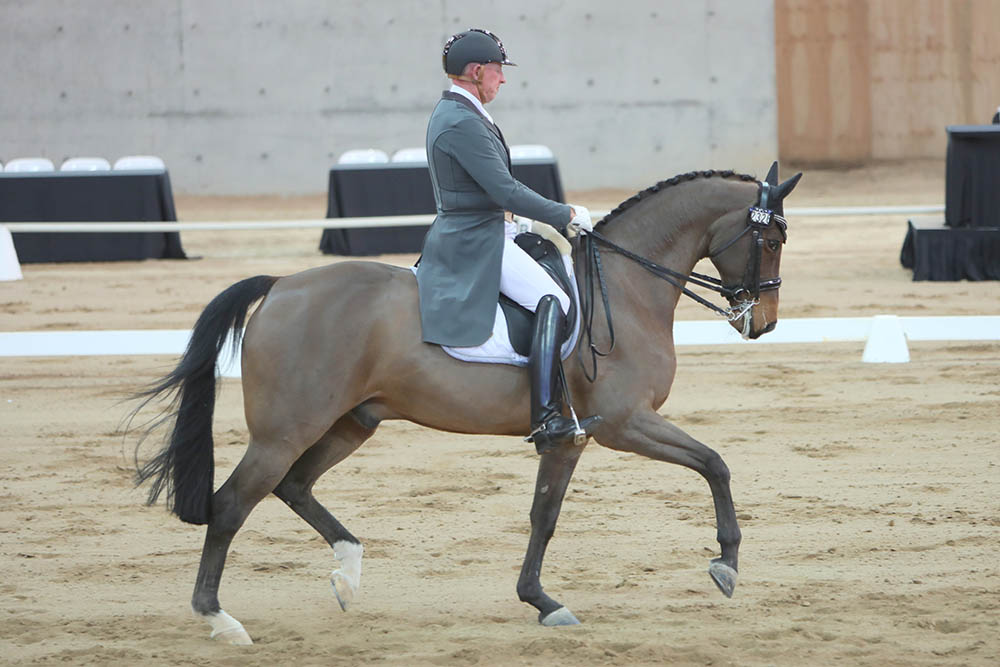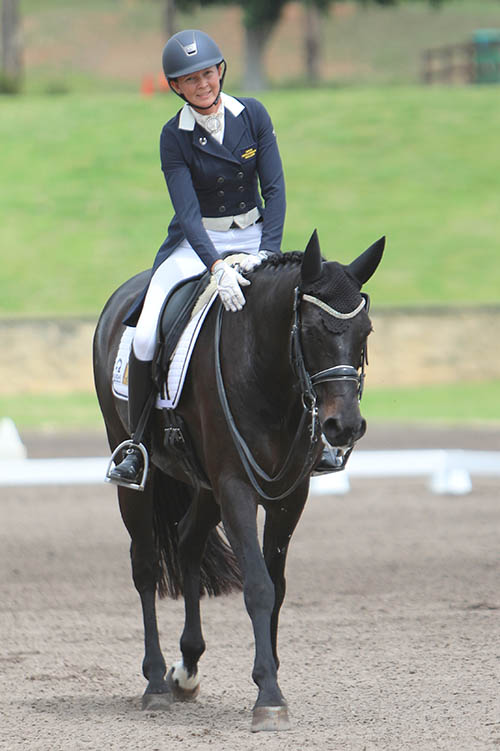In previous editions of Equestrian Life, Roger Fitzhardinge has given us handy tips for riding the Equestrian Australia national tests, from Preliminary through to Advanced. The next step for a dressage combination rising up through the ranks is to compete FEI Small Tour, the first test of which is the Prix St Georges (PSG).

“If you get a 70%
in the PSG test you’re
doing well.”
As Roger explains, this test is really no harder than the Advanced level tests. In fact, in many ways the flow is a little better and some find it easier — especially compared to the 5C! However, that being said the PSG test is not an easy test to gain marks in.
“It often marks low,” explains Roger. “If you get a 70% in the PSG test you’re doing well, as it’s always a low scoring test. I believe this is because some of the coefficient movements, for example the canter pirouettes, are often ridden poorly and may only get marked at a 5 or 4; you can lose 2% in those movements easily. There’s not that many coefficients in the test, so you’ve got to really make certain that the coefficients that are included are performed well.”
So, how do you get those elusive marks in the PSG test?
1. Make a great first impression with the entry in canter.
“For the entry, make certain that the canter is very collected to almost cantering on the spot before you halt, and then it should feel like you melt down into the halt; it can’t be abrupt. So it’s canter, then very collected canter, to cantering on the spot, to lowering the forehand lightly to the ground, and the very last step into the halt will be a walk step. Because in the canter, one front leg at a time extends further than the other of course, so when that leading foreleg hits the ground, the last step is the opposite foreleg stepping up into the halt,” says Roger. “You must be very straight, and the departure out of the halt must be direct and forward going. You need to go from halt to trot.
“If your horse is equal to the left and right in canter, I would always canter in on the right leg, because the first turn is to the right. So then your horse is positioned ever so slightly to the right to X, through the halt — even through he’s straight there’s a little indication to the right — and then when you depart, there’s a very slight indication right, so you’re prepared to turn right at C.”
2. Ride clear transitions into and out of the medium trot — and ensure the transition back to collected trot is before the corner.
“With the medium trot, it’s very important to make a clear transition into it,” emphasises Roger. “So you go through the corner, onto a diagonal line, and immediately straighten the horse with the outside rein so that you’re not drifting to the left with inside flexion. As you straighten, you collect for a few steps, then medium trot. And then at the other end, make certain that you maintain the medium trot within three strides of the long side, and then make the transition on the diagonal before turning onto the long side; don’t keep making a transition once you get on the long side and go through the corner. It’s very important to make your transition back to collected trot at the end of the diagonal and then allow the horse a little forward through the corner.
“Also, you must remember that the medium trot is not just the biggest trot you can do; because it’s medium for the first diagonal and the second diagonal is the extended trot, so there has got to be a difference. You’ve got to make sure that your medium trot has enough in reserve!”
3. Plan your half-pass as you finish the 8-metre volte and make sure you finish with the horse straight on the centreline.
“Make certain that you finish the 8-metre volte a little bit short of the long side. The last step of your circle is a leg-yield feeling away from the inside leg towards the wall, so you get the balance of the horse to the outside and then begin the half-pass with the shoulders slightly advanced,” says Roger.
“As you get to the centreline and before you turn left (after the half-pass left) or transition to collected walk (after the half-pass right), you need to make the horse straighter and straighter and straighter, so that you end up on the centreline on two tracks by G. In other words, the judge at C would see a left front leg and left hind leg on one line, and the right fore and right hind on the other line; make sure you don’t end up on the centreline in travers position.”



“It’s always important to
know your horse’s strengths
and weaknesses.”
4. Make sure the horse stays balanced into and out of the extended trot.
The extended trot is covered by two marks in the PSG test — one for the trot itself, and then another mark for the two transitions (the latter also covers the short section of collected trot that follows). As Roger explains, it’s crucial to nail those transitions.
“As you turn onto the diagonal line, like the medium trot you need to immediately straighten the horse with the outside rein so that you’re not drifting to the right with inside flexion. Don’t let the horse run off into extended trot; you sit the horse up and in, and make use of the hind leg, and then you ride the horse up and forward with big expansive strides. Don’t let the horse tip forward or lose balance.
“Make certain that you ride a transition back to collected trot with a little shoulder-fore to the right as you get to the long side, as this helps to engage the inside hind leg and makes the balance and the collection very obvious, so you get a good mark for the transitions.”
5. Be methodical about the position of the half-pirouettes in walk… And remember the collected walk receives its own mark.
The collected walk and half-pirouettes in walk follow the trot half-pass. As Roger explains for this movement, “It’s half-pass, collect, straighten, flexion left (preparing to track left at C), position left, walk at G, walk two or three strides straight, then make the corner (towards H), then a straight line and a corner as you turn left across the school at H, then you make a half-pirouette left between G and M, and then you go back and make the half-pirouette right between G and H.
“It’s important to make those two pirouettes in the same symmetrical position on that line across the school. If you start with the front feet right up to the boards on one side, that’s what you should do on the other; everything should be disciplined and symmetrical.
“Make certain that when you finish the walk pirouette, the first one is left so you finish in position left. As you cross the centreline, you put the horse in shoulder fore right, in preparation for the half-pirouette right, and then keep the bend and flexion when you finish, because you’re going to track right when you get to M.”
It’s always important to know your horse’s strengths and weaknesses. “If you’ve got a horse with a poor walk, make the pirouettes closer to the centreline; don’t walk right to the long side before you do them!” notes Roger.
Roger also points out that as you’ll see on the test sheet for movement 13, the collected walk receives its own mark — and it’s a coefficient mark. “You must make a good collected walk; one where you feel that it’s a collected walk that is on the aids and you could do anything from, whether it be piaffe, halt, or extended walk.”

“If ridden well this
transition can provide a
valuable percentage boost!”
6. The transition from collected walk to collected canter is an opportunity to pick up marks.
The transition from collected walk to collected canter at K (movement 15) is worth 10 marks (the canter KAF is also judged here, but the transition really is the bulk of the mark). As Roger explains, if ridden well this transition can provide a valuable percentage boost!
“There are a few collected walk steps at the end of the extended walk, so you collect and then make the canter transition at K. You can’t afford to jog, so make certain the horse doesn’t anticipate the canter.”
Although Roger often recommends riding movements in the warm-up as they appear in the test to prepare, that is not the case for this transition. “Don’t practise that movement exactly as it is in the test in your warm-up; instead, do the extended walk, make a collected walk and make them walk all the way around past A, and then make the canter transition there in your warm-up so they’re not anticipating the transition in the test.
“Also, the transition is at K, so you canter forward straight for a stride or two before you turn the corner. You don’t make the transition on a curving line; it goes a couple of collected walk steps, canter, straight, then the corner, then straight, then the corner, and then the mark goes down. It’s an easy movement to pick up marks, but you’ve got to ride it impressively.”
7. The half-pirouettes in canter are important in more ways than one.
As mentioned at the beginning of this article, the canter pirouettes are tricky and often not done well. Being coefficient marks, they do have a strong bearing on the outcome of the test.
As Roger explains, the positioning is important: “Coming out of the half-pass and into collected canter, you go around the corner and onto the diagonal for the half-pirouette. From H, ride the line for the pirouette with your eyes looking towards the opposite corner, not F. Then you’ll end up on a good line for the pirouette (which is between H and X).
“You must get the canter back until you are cantering on the spot, and then turn the forehand around the back end, keeping the position to the left (or right, for the second pirouette). You need that position for the counter canter that follows.”
Roger also explains that in the PSG test, one of the big things the judge needs to see is adjustability in the horse — and the canter pirouettes help to show this.
“For me, the adjustability will come in movements like the canter pirouettes. So you ride out of the canter pirouette in a forward, desirous way… not still in a half-canter-pirouette-canter; it’s got to be collect, collect, collect, pirouette, and then canter forward out of it. So you show a clear difference between the collected canter and the pirouette canter.

“If you’ve got adjustability
and good balance, then you
must be riding well!”
“Too many people don’t get a pirouette canter going; they do it in collected canter. They go collected canter, then the pirouette (which will always be too big if ridden in collected canter rather than a true pirouette canter), and then it’s just collected canter out. So there’s no adjustability; the ability to engage, shorten and collect into the pirouette canter, and ride into and out of that from collected canter… that’s what you’ve really got to look for.”
8. You must ride the corners in the counter canter.
The counter canter and change that follows the pirouettes needs to be ridden through the corner, not on a half-20-metre-circle curving line.
“When you finish the pirouettes, you ride the corner in counter canter, then it’s a straight line, and the flying change at C, and then a straight line after the change.
“It’s very important to show that you have the control; that you can keep the counter canter and keep it adjustable with the quarters on the wall and very parallel, and that you can make a flying change in a straight line, not on a half-20-metre circle line, but a straight line,” explains Roger.
9. Maintain focus for the tempi changes.
It goes without saying that you need to stay focused during the entire test, however, Roger explains that many riders subconsciously relax a little after the dreaded canter pirouettes and counter canter.
“Make certain that from the end of that counter canter, once you’ve done the flying change, don’t go to sleep! Everybody takes a big sigh thinking they’ve got through the difficult pirouettes and the counter canter… but all of a sudden you’ve got the four tempi changes.
“Believe me, there’s a tendency in the counter canter for the horse to be getting a little bit open and flat. And then you relax a little bit because you think that tough bit is done, but then you’ve got a sequence of five fours. You’ve got to make sure that you make that canter very active and collected and bouncy, so you’re really prepared for the changes before you get onto the diagonal line.
“As you go onto the diagonal line, it is of the utmost importance to straighten the horse with the outside rein and have a feeling that he’s almost moving slightly left, so that the balance frees up the inside of the horse. It is important to have a straight horse with a feeling that you can change the balance from left to right and vice versa, as this allows freedom of the new inside of the horse for the change.
“There are five fours, and the middle change (third change) should be over X. So it’s up to you at home to count how many strides out you can be before you begin the fours, so there is then the same number of strides at the end of the diagonal line when you finish the fours to the long side. It’s then exactly the same principle in the three tempi changes.”
10. Your horse must stand still at the end!
This goes for the final halt in any test at any level: your horse must stand motionless for the final halt and not walk off until they’re asked.
“After you’ve saluted, let the reins go and the horse should remain standing still. Give the horse a pat and then you ask them to walk off. Do not let the horse walk off from the halt before you ask. It’s a big no-no and it will lose you up to two or three marks, believe me. That’s the difference between winning and being out of the placings!”
In the PSG test there is just one collective mark, for “rider’s position and seat; correctness and effect of the aids”. As Roger explains, this is far more than just a rider mark.
“The collective mark is really the way the horse goes in the test and the accuracy of the movements. It is the overall impression of submission, impulsion, freedom, transitions, flexibility, rider position… and of course balance and adjustability. If you’ve got adjustability and good balance, then you must be riding well! EQ
View the FEI Prix St Georges test here.
Riding the Preliminary, Novice, Elementary, Medium or Advanced tests? Roger has covered these in our previous issues:
10 Tips for Riding the Preliminary Tests
10 Tips for Riding the Novice Tests
10 Tips for Riding the Elementary Tests
10 Tips for Riding the Medium Tests
10 Tips for Riding the Advanced Tests

